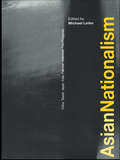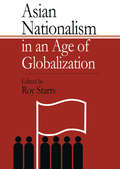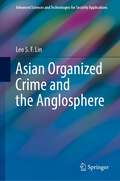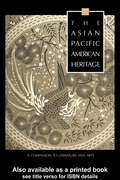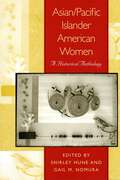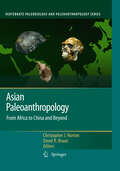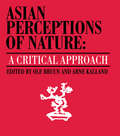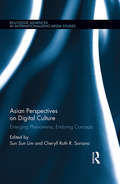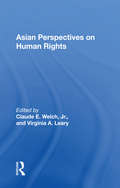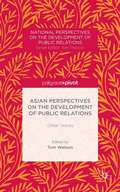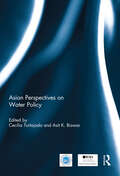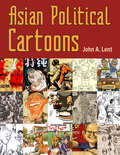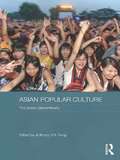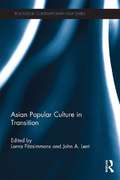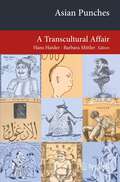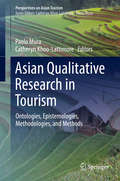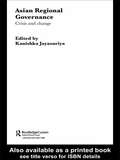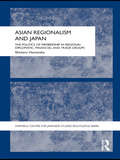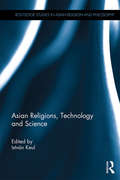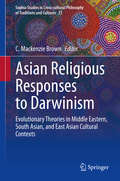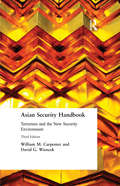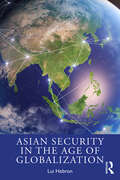- Table View
- List View
The Asian Mystique: Dragon Ladies, Geisha Girls, and Our Fantasies of the Exotic Orient
by Sheridan PrassoFew Westerners escape the images, expectations and misperceptions that lead us to see Asia as exotic, sensual, decadent, dangerous, and mysterious. Despite -- and because of -- centuries of East-West interaction, the stereotypes of Western literature, stage, and screen remain pervasive icons: the tea-pouring, submissive, sexually available geisha girl; the steely cold dragon lady dominatrix; as well as the portrayal of the Asian male as effeminate and asexual. These "Oriental" illusions color our relations and relationships in ways even well-respected professional "Asia hands" and scholars don't necessarily see. The Asian Mystique lays out a provocative challenge to see Asia and Asians as they really are, with unclouded, deeroticized eyes. It traces the origins of Western stereotypes in history and in Hollywood, examines the phenomenon of 'yellow fever,' then goes on a reality tour of Asia's go-go bars, middle-class homes, college campuses, business districts, and corridors of power, providing intimate profiles of women's lives and vivid portraits of the human side of an Asia we usually mythologize too well to really understand. It strips away our misconceptions and stereotypes, revealing instead the fully dimensional human beings beyond our usual perceptions. The Asian Mystique is required reading for anyone with interest in or interaction with Asia or Asian-origin people, as well as any serious student or practicioner of East-West relations.
Asian Nationalism
by Michael LeiferAsian Nationalism brings together internationally renowned experts in the field analysing current theories of nationalism. Featuring detailed chapter case-studies on Pakistan, China, Japan, Taiwan, India, Indonesia and the Philippines, this book provides a good balance of theoretical and empirical material.Completely up-to-date, this book will be invaluable for scholars of both Asian Studies and Politics. Key issues covered include: theories of nationalismthe changing faces of Chinese nationalismIndian National Democracythe imagined communityreflections on Asian nationalism.
Asian Nationalism in an Age of Globalization
by Roy StarrsTopics include: Government Intervention and Economic Growth in East Asia, Agricultural Nationalism in the Age of Globalization, Japan's Dominance and Multi- Racial Coalitions in Malaysia.
Asian Organized Crime and the Anglosphere (Advanced Sciences and Technologies for Security Applications)
by Leo S. LinIn this book, "Asian Organized Crime and the Anglosphere," the author uncovers the multifaceted phenomenon of Asian Organized Crime (AOC) and its profound impact on nation-states, with particular emphasis on English-speaking countries. From the United States and Canada, to the United Kingdom, to Australia and New Zealand; each chapter delves into the intricate dynamics and transnational operations of Asian criminal groups. The book explores the diverse responses and strategies employed by these countries, shedding light on the categories of AOC, ranging from traditional criminal activities rooted in Asian countries to high-tech transnational crimes that have rapidly expanded into Western nations. Readers will gain insights into the presence and impact of prominent Asian criminal groups operating within the Anglosphere. Focusing on national and homeland security implications, this book equips professionals, students, practitioners, and academics with the knowledge to understand, counter, and combat Asian organized crime.
The Asian Pacific American Heritage: A Companion to Literature and Arts (Reference Library Of The Humanities #Vol. 2109)
by George J. Leonard Peter Bacho Jeffery Chan Leo Chen Daniel Gonzales Evelyn Hu-Dehart David Hyun Amy Ling S. E. SolbergMeeting the challenge of teaching multiculturalismStudents-and their teachers-encountering literature and arts from unfamiliar cultures will welcome the special help this book provides. Instructors who are unfamiliar with Asian Pacific cultures are now being asked to explain a reference to the Year of the Rat, Obon Season, or to interpret a haiku. When Amy Tan refers to the Moon Lady or the Kitchen God, what does she mean? Is Confucianism actually a religion? This book answers these and many other questions, for students, teachers, and the librarians to whom they turn for help.Provides sound information on in-demand topicsThe Companion presents lengthy articles-written specifically for this book-on the topics that unlock the work of a number of contemporary Asian Pacific American writers and artists, for example: Asian naming systems, the "model minority" discourse, Chinese diaspora, Filipino American values, the Confucian family and its tensions, Japanese internment, Mao's Great Cultural Revolution, the Korean alphabet, food and ethnic identity, religious traditions, Fengshui and Chinese medicine, Filipino folk religion, Hmong needlework, and reading Asian characters in English, just to name a few.Covers major contemporary writersThe articles are coupled with in-depth studies of the authors most likely to be part of the multicultural curriculum during the next decade, among them Maxine Hong Kingston, Frank Chin, Amy Tan, Younghill Kang, Carlos Bulosan, Jessica Hagedorn, Lawson Fusao Inada, Garret Hongo, David Henry Hwang, Kim Ronyoung, and Cathy Song.Expert contributorsThis volume was created under the supervision of distinguished Advisory Editors from the Asian Pacific American community. The contributors, a Who's Who of Asian Pacific American humanistic scholarship, are frequently the founders of their disciplines, and most are from the ethnic group being written about.Helps students understand arts and literatureMulticultural courses are generally taught by exposing students to literature or arts, with reference to their political, sociological, and historical contexts. This book is designed to help students reading novels, watching films, and confronting artworks with information needs quite different from those of social scientists and historians.
Asian/Pacific Islander American Women: A Historical Anthology
by Shirley Hune and Gail M. NomuraA groundbreaking anthology devoted to Asian/Pacific Islander American women and their experiencesAsian/Pacific Islander American Women is the first collection devoted to the historical study of A/PI women's diverse experiences in America. Covering a broad terrain from pre-large scale Asian emigration and Hawaii in its pre-Western contact period to the continental United States, the Philippines, and Guam at the end of the twentieth century, the text views women as historical subjects actively negotiating complex hierarchies of power. The volume presents new findings about a range of groups, including recent immigrants to the U.S. and understudied communities. Comprised of original new work, it includes chapters on women who are Cambodian, Chamorro, Chinese, Filipino, Hmong, Japanese, Korean, Native Hawaiian, South Asian, and Vietnamese Americans. It addresses a wide range of women's experiences-as immigrants, military brides, refugees, American born, lesbians, workers, mothers, beauty contestants, and community activists. There are also pieces on historiography and methodology, and bibliographic and video documentary resources.This groundbreaking anthology is an important addition to the scholarship in Asian/Pacific American studies, ethnic studies, American studies, women's studies, and U.S. history, and is a valuable resource for scholars and students. Contributors include: Xiaolan Bao, Sucheng Chan, Catherine Ceniza Choy, Vivian Loyola Dames, Jennifer Gee, Madhulika S. Khandelwal, Lili M. Kim, Nancy In Kyung Kim, Erika Lee, Shirley Jennifer Lim, Valerie Matsumoto, Sucheta Mazumdar, Davianna Pomaika'i McGregor, Trinity A. Ordona, Rhacel Salazar Parreñas, Amy Ku'uleialoha Stillman, Charlene Tung, Kathleen Uno, Linda Trinh Võ, Judy Tzu-Chun Wu, Ji-Yeon Yuh, and Judy Yung.
Asian Paleoanthropology: From Africa to China and Beyond (Vertebrate Paleobiology and Paleoanthropology)
by Christopher J. Norton David R. BraunThis volume brings together a group of authors that address the question of the first out of Africa into Asia c. 2 Ma. The scope of the book is comprehensive as it covers almost every major region of Asia. The primary goal of this volume is to provide an updated synthesis of the current state of the Asian paleoanthropological and paleoenvironmental records. Papers include detailed studies of the theoretical constructs underlying the move out of Africa, including detailed reconstructions of the paleoenvironment and possible migration routes. Other papers detail the Plio-Pleistocene archaeological and hominin fossil records of particular regions.
Asian Perceptions of Nature: A Critical Approach
by Arne Kalland Ole BruunThis highly acclaimed, 'bold and refreshing' collection of essays takes a critical look at Asians' perception of their natural environments as well as at Western views of Asia in this respect.
Asian Perspectives on Animal Ethics: Rethinking the Nonhuman
by Chloë Taylor Neil DalalTo date, philosophical discussions of animal ethics and Critical Animal Studies have been dominated by Western perspectives and Western thinkers. This book makes a novel contribution to animal ethics in showing the range and richness of ideas offered to these fields by diverse Asian traditions. Asian Perspectives on Animal Ethics is the first of its kind to include the intersection of Asian and European traditions with respect to human and nonhuman relations. Presenting a series of studies focusing on specific Asian traditions, as well as studies that put those traditions in dialogue with Western thinkers, this book looks at Asian philosophical doctrines concerning compassion and nonviolence as these apply to nonhuman animals, as well as the moral rights and status of nonhuman animals in Asian traditions. Using Asian perspectives to explore ontological, ethical and political questions, contributors analyze humanism and post-humanism in Asian and comparative traditions and offer insight into the special ethical relations between humans and other particular species of animals. This book will be of interest to students and scholars of Asian religion and philosophy, as well as to those interested in animal ethics and Critical Animal Studies.
Asian Perspectives on Digital Culture: Emerging Phenomena, Enduring Concepts (Routledge Advances in Internationalizing Media Studies)
by Sun Sun Lim Cheryll SorianoIn Asia, amidst its varied levels of economic development and diverse cultural traditions and political regimes, the Internet and mobile communications are increasingly used in every aspect of life. Yet the analytical frames used to understand the impact of digital media on Asia predominantly originate from the Global North, neither rooted in Asia’s rich philosophical traditions, nor reflective of the sociocultural practices of this dynamic region. This volume examines digital phenomena and its impact on Asia by drawing on specifically Asian perspectives. Contributors apply a variety of Asian theoretical frameworks including guanxi, face, qing, dharma and karma. With chapters focusing on emerging digital trends in China, Hong Kong, India, Japan, Korea, Philippines, Singapore, and Taiwan, the book presents compelling and diverse research on identity and selfhood, spirituality, social networking, corporate image, and national identity as shaped by and articulated through digital communication platforms.
Asian Perspectives On Human Rights
by Claude WelchAnalyzes Asian perspectives on human rights in terms of cultural traditions, grassroots and regional organizations, and economic constraints on the expression of rights. The book asks: are human rights western in their inception, are they universal or do they differ by region and culture.
Asian Perspectives on the Development of Public Relations: Other Voices
by Tom WatsonThe National Perspectives on the Development of Public Relations: Other Voices series is the first to offer an authentic world-wide view of the history of public relations. It will feature six books, five of which will cover continental and regional groups. This first book in the series focuses on Asia and Australasia.
Asian Perspectives on Water Policy (Routledge Special Issues on Water Policy and Governance)
by Cecilia Tortajada Asit K. BiswasAsian countries are not homogenous. They are in different stages of social and economic development, with cultural conditions and institutional and legal frameworks varying from one country to another. Therefore, how water can be successfully managed differs from one country to another. The book provides authoritative analyses of how water is being managed in different Asian countries, ranging from the world’s most populous countries like China and India to a city state like Singapore and an island country like Fiji. It also analyses in depth several wide ranging issues like terrorism, human rights, water-energy nexus, and roles of media, along with comprehensive discussions of legal, institutional and regulatory frameworks in an Asian water management context. The overall focus is on how water can be managed efficiently, cost-effectively and equitably in various Asian countries.This book was based on a special issue of the International Journal of Water Resources Development.
Asian Political Cartoons
by John A. Lent2023 CHOICE Outstanding Academic TitleIn Asian Political Cartoons, scholar John A. Lent explores the history and contemporary status of political cartooning in Asia, including East Asia (China, Hong Kong, Japan, North and South Korea, Mongolia, and Taiwan), Southeast Asia (Brunei, Cambodia, Indonesia, Malaysia, Myanmar, Philippines, Singapore, Thailand, and Vietnam), and South Asia (Bangladesh, India, Iran, Nepal, Pakistan, and Sri Lanka).Incorporating hundreds of interviews, as well as textual analysis of cartoons; observation of workplaces, companies, and cartoonists at work; and historical research, Lent offers not only the first such survey in English, but the most complete and detailed in any language. Richly illustrated, this volume brings much-needed attention to the political cartoons of a region that has accelerated faster and more expansively economically, culturally, and in other ways than perhaps any other part of the world. Emphasizing the “freedom to cartoon," the author examines political cartoons that attempt to expose, bring attention to, blame or condemn, satirically mock, and caricaturize problems and their perpetrators. Lent presents readers a pioneering survey of such political cartooning in twenty-two countries and territories, studying aspects of professionalism, cartoonists’ work environments, philosophies and influences, the state of newspaper and magazine industries, the state’s roles in political cartooning, modern technology, and other issues facing political cartoonists. Asian Political Cartoons encompasses topics such as political and social satire in Asia during ancient times, humor/cartoon magazines established by Western colonists, and propaganda cartoons employed in independence campaigns. The volume also explores stumbling blocks contemporary cartoonists must hurdle, including new or beefed-up restrictions and regulations, a dwindling number of publishing venues, protected vested interests of conglomerate-owned media, and political correctness gone awry. In these pages, cartoonists recount intriguing ways they cope with restrictions—through layered hidden messages, by using other platforms, and finding unique means to use cartooning to make a living.
Asian Popular Culture: The Global (Dis)continuity (Media, Culture and Social Change in Asia)
by Anthony Y.H. FungThis book examines different aspects of Asian popular culture, including films, TV, music, comedy, folklore, cultural icons, the Internet and theme parks. It raises important questions such as – What are the implications of popularity of Asian popular culture for globalization? Do regional forces impede the globalizing of cultures? Or does the Asian popular culture flow act as a catalyst or conveying channel for cultural globalization? Does the globalization of culture pose a threat to local culture? It addresses two seemingly contradictory and yet parallel processes in the circulation of Asian popular culture: the interconnectedness between Asian popular culture and western culture in an era of cultural globalization that turns subjects such as Pokémon, Hip Hop or Cosmopolitan into truly global phenomena, and the local derivatives and versions of global culture that are necessarily disconnected from their origins in order to cater for the local market. It thereby presents a collective argument that, whilst local social formations, and patterns of consumption and participation in Asia are still very much dependent on global cultural developments and the phenomena of modernity, yet such dependence is often concretized, reshaped and distorted by the local media to cater for the local market.
Asian Popular Culture in Transition (Routledge Contemporary Asia Series)
by Lorna Fitzsimmons John A. LentAsian Popular Culture in Transition examines contemporary consumption practices in South Korea, China, India, and Japan, and both updates and extends popular culture studies of the region. Through an interdisciplinary lens, this collection of essays explores how recent advances and shifts in information technologies and globalization have impacted cultural markets, fashion, the digital generation, mobile culture, femininity, matrimonial advertising, and a film actress’ image and performance. Drawing upon a diverse range of sources and methods including historical research, content analysis, anthropological observation, textual analyses, and interviews, Asian Popular Culture in Transition makes a significant contribution to this growing area of research. Given its broad range of countries, theories, and approaches, this book will be of great interest to students and scholars of Asian studies, cultural studies, media and communication studies, and gender studies.
Asian Punches: A Transcultural Affair (Transcultural Research – Heidelberg Studies on Asia and Europe in a Global Context)
by Barbara Mittler Hans HarderThis book deals with Punches and Punch-like magazines in 19th and 20th century Asia, covering an area from Egypt and the Ottoman Empire in the West via British India up to China and Japan in the East. It traces an alternative and largely unacknowledged side of the history of this popular British periodical, and simultaneously casts a wide-reaching comparative glance on the genesis of satirical journalism in various Asian countries. Demonstrating the spread of both textual and visual satire, it is an apt demonstration of the transcultural trajectory of a format intimately linked to media-bound public spheres evolving in the period concerned.
Asian Qualitative Research in Tourism: Ontologies, Epistemologies, Methodologies, And Methods (Perspectives On Asian Tourism)
by Paolo Mura Catheryn Khoo-LattimoreAddresses the issues and opportunities faced by researchers conducting qualitative tourism research in Asia.<P> Provides reflexive accounts from Asian tourism scholars as well as non-Asian academics who focus on the region.<P> Pulls together the work of both authoritative figures in the field and emerging qualitative tourism researchers.<P>This book explores the ontologies, epistemologies, methodologies, and methods that inform tourism qualitative research conducted either by Asian scholars or non-Asian scholars focusing on Asia. In addition to providing a platform for researchers to publish their qualitative journeys, it aims to encourage further Asian qualitative tourism research production.<P> The book not only includes chapters from Asian scholars but also non-Asian tourism researchers with a focus on Asia, as their chapters are crucial to represent the multiplicity of realities constituting ‘Asia’. It is of interest to the whole tourism academic community as it provides novel methodological insights from a non-Western perspective, which at the moment are often silenced by dominant (Western) voices.
Asian Regional Governance: Crisis and Change (Routledge/City University of Hong Kong Southeast Asia Series)
by Kanishka JayasuriyaJayasuriya looks at the changing global and domestic political economies shaping the new regionalism in Asia, and examines the relationship between regional domestic, political and economic structures and forms of regional governance. Well-known contributors in the field focus on the impact of globalization on Asian regionalism, new security challenges, monetary cooperation, sovereignty, democratization, industry policy and China's engagement with southeast Asia. Providing a detailed overview of the conceptual foundations of regional governance, this text is an indispensable resource for all who want to understand the emerging dynamics of regionalism in the Asia Pacific.
Asian Regionalism and Japan: The Politics of Membership in Regional Diplomatic, Financial and Trade Groups (The University of Sheffield/Routledge Japanese Studies Series)
by Shintaro HamanakaThis book explores the essential nature of regionalism by conducting a comprehensive analysis of more than 30 regionalist proposals made by Japan and other Asian countries throughout the post-war period. Shintaro Hamanaka examines the whole post war period and covers all regionalist proposals since then, while most existing studies cover only the development of Asian regionalism in the recent decade. A significant number of cases in the proposed book enable the readers to go beyond an understanding of each regionalist project, to a deeper understanding of theoretically generalizeable behavior pattern of Japan and other countries. The book also comparatively analyzes political, financial and trade regionalisms. The central aim of the book is to reveal the fact that policies with regard to regionalism have a pattern, in this case with a principal, though not an exclusive focus, on Japan. The author demonstrates that the behavior pattern of external policy is extremely consistent in terms of the membership of regionalist organizations and discusses whether this new approach to regionalism holds explanatory power vis-à-vis regionalism outside Asia. This book will be of interest to scholars, postgraduate students and policy makers in the fields of international relations, Asian studies, international trade and regionalism.
Asian Religions, Technology and Science
by IstvánOver the past five decades, the field of religion-and-science scholarship has experienced a considerable expansion. This volume explores the historical and contemporary perspectives of the relationship between religion, technology and science with a focus on South and East Asia. These three areas are not seen as monolithic entities, but as discursive fields embedded in dynamic processes of cultural exchange and transformation. Bridging these arenas of knowledge and practice traditionally seen as distinct and disconnected, the book reflects on the ways of exploring the various dimensions of their interconnection. Through its various chapters, the collection provides an examination of the use of modern scientific concepts in the theologies of new religious organizations, and challenges the traditional notions of space by Western scientific conceptions in the 19th century. It looks at the synthesis of ritual elements and medical treatment in China and India, and at new funeral practices in Japan. It discusses the intersections between contemporary Western Buddhism, modern technology, and global culture, and goes on to look at women’s rights in contemporary Pakistani media. Using case studies grounded in carefully delineated temporal and regional frameworks, chapters are grouped in two sections; one on religion and science, and another on religion and technology. Illustrating the manifold perspectives and the potential for further research and discussion, this book is an important contribution to the studies of Asian Religion, Science and Technology, and Religion and Philosophy.
Asian Religious Responses to Darwinism: Evolutionary Theories in Middle Eastern, South Asian, and East Asian Cultural Contexts (Sophia Studies in Cross-cultural Philosophy of Traditions and Cultures #33)
by C. Mackenzie BrownThis volume brings together diverse Asian religious perspectives to address critical issues in the encounter between tradition and modern western evolutionary thought. Such thought encompasses the biological theories of Charles Darwin, Jean-Baptiste Lamarck, Earnest Haeckel, Thomas Huxley, and later “neo-Darwinians,” as well as the more sociological evolutionary theories of thinkers such as Herbert Spencer, Pyotr Kropotkin, and Henri Bergson. The essays in this volume cover responses from Hindu, Jain, Buddhist (Chinese, Japanese, and Indo-Tibetan), Confucian, Daoist, and Muslim traditions. These responses come from the decades immediately after publication of The Origin of Species up to the present, with attention being paid to earlier perspectives and teachings within a tradition that have affected responses to Darwinism and western evolutionary thought in general. The book focuses on three critical issues: the struggle for survival and the moral implications read into it; genetic variation and its seeming randomness as related to the problems of meaning and purpose; and the nature of humankind and human exceptionalism. Each essay deals with one or more of the three issues within the context of a specific tradition.
Asian Security Handbook: Terrorism and the New Security Environment
by William M. Carpenter David G. Wiencek James R. LilleyThis thoroughly revised and updated edition of Asian Security Handbook focuses on the new challenges to security in the Asia-Pacific region presented by international terrorism. It reviews old security realities covered in previous editions, and highlights more recent security issues in the region, including the North Korean threat, weapons of mass destruction proliferation, the South China Sea dispute, and the future U.S.-China rivalry. Featuring contributions by a distinguished group of international security and Asia experts, this new edition has been reformatted and restructured. A new introductory chapter on terrorism sets the stage for the country-by-country profiles and assessments of the political-security situations in twenty-three individual nations. A new appendix on foreign terrorist organizations is also included.
Asian Security in the Age of Globalization
by Lui HebronThis book examines the security challenges and opportunities that the nation-states of Asia confront in an era of globalization. With consideration of the increasingly border-less nature of international relations via the integrative process of globalization, this book explores the emerging threats to regional and national security in Asia. It looks beyond traditional military threats, analysing non-traditional aspects of security including economic, social, environmental, transnational, energy, health concerns and threats posed by organized-crime groups. Its approach is organized both theoretically and, in a country-specific, case study form which provides contemporary examples of the threats faced in the region. By acknowledging that contemporary Asian security has become much more complex and complicated, it highlights the uncertainty and instability that the nation-states of the Indo-Pacific region confront. Presenting both a globally oriented and expanded vision of Asian security, this book is an excellent resource for scholars and students of Asian Studies, International Relations and Global Studies.
Asian Slaves in Colonial Mexico
by Tatiana Seijas"During the late sixteenth and seventeenth centuries, countless slaves from culturally diverse communities in the Indian subcontinent and Southeast Asia journeyed to Mexico on the ships of the Manila Galleon. Upon arrival in Mexico, they were grouped together and categorized as chinos. In time, chinos came to be treated under the law as Indians (the term for all native people of Spain's colonies) and became indigenous vassals of the Spanish crown after 1672. The implications of this legal change were enormous: as Indians, rather than chinos, they could no longer be held as slaves. By tracking these individuals' complex journey from the bondage of the Manila slave market to the freedom of Mexico City streets, Tatiana Seijas challenges commonly held assumptions about the uniformity of the slave experience in the Americas and shows that the history of coerced labor is necessarily connected to colonial expansion and forced global migration"--

